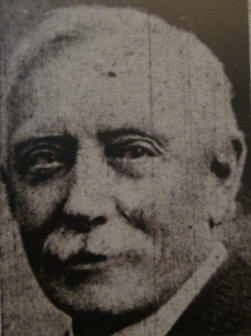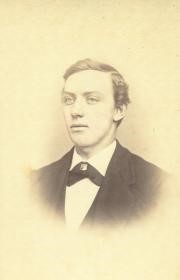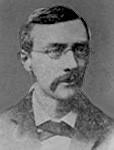William Parker Headden
(1850-1932)
President of the Colorado Scientific Society – 1891
President 1891, Honorary member 1907

- Soil scientist, chemist
- Prof. of Chemistry at Colorado Agriculture and Mechanic Arts, Fort Collins, Colorado; Prof of Chemistry and Physics, Denver Univ.; Prof. of Chemistry, School of Mines, Rapid City, South Dakota; Prof. of Chemistry, Maryland Agricultural College
- Chief Chemist of the Colorado Experiment Station
- A. B. and A. M., Dickinson; Ph.D., Giessen
- Authority on rare earth elements
- Author of chapters in textbooks and many articles about minerals, ore deposits, coal, and water in Colorado, South Dakota and Missouri
Short Biography
by Beth Simmons, Colorado Scientific Society Historian
William Parker Headden (Sept. 1, 1850-Feb. 5, 1932)

William Parker Headden was born in 1850 in Monmouth, New Jersey. He prepared for college at Pennington Seminary, then earned his undergraduate degree from Pennsylvania’s Dickinson College in 1872 and in 1874 earned his Doctorate from the University of Giessen in Germany. In today’s vernacular, he would be classified as an analytical chemist.
Returning to America, he was the assistant chemist at the U. Pennsylvania from 1874-1876, after which he moved to Maryland Agricultural College with his new wife, Alice Ralston and oldest daughter, Helen Parker Headden, who was born in New Jersey. His son, William Ralston Headden, was born in Maryland in 1881; by the end of 1883, there was a second daughter, Mary, born in 1883 in Pennsylvania. The third daughter, Margaret, was born in Colorado in 1887.

In 1882, the University of Denver hired Headden as its first well-defined chemist. His five-year stint at the University of Denver was rife with conflict because the students complained that he was too difficult. Eventually, after a “hearing” with a committee chaired by Governor Evans, he tendered his resignation. But it was denied. In June of 1887, he became Professor of Geology, Mineralogy, and Analytical Chemistry but in 1888, Headden was terminated due “to financial considerations.” Through the letter he received, the university took the “opportunity to declare their (the board’s) high appreciation of Dr. W. P. Headden for five years the able representative of their department of Natural Science.” They thanked him further for his “splendid record as a teacher,” and ranked him “among the most exacting scientists of our commonwealth.”
In October of 1885, three years after its inception, Headden had joined the Colorado Scientific Society and in 1888 published his first article of many in the Society’s Proceedings. In 1891, he was elected President. In 1907, along with the other early presidents, he was made an Honorary Fellow of the Society.
In 1888, after the University of Denver debacle, Headden moved to Rapid City, South Dakota, where he had been appointed professor of chemistry. Terminated there in 1890, in 1891, he was rehired as the President of the School of Mines in Rapid City, South Dakota. During Headden’s tenure as President, he formalized prep school courses and offered night bookkeeping classes for local residents. Headden opened the campus to the public, inviting them to attend lectures on chemistry and assaying; he also appointed the institution’s first Professor Emeritus.
In 1893, Headden left the South Dakota School of Mines for his life-time position – head of the chemical section of the Experiment Station at Colorado A. & M (later renamed Colorado State University). His 38-year career there earned him an international reputation as a dedicated researcher and prolific writer in chemistry, mineralogy, agriculture, and agronomy. Headden published hundreds of his assays, analyses, and reports, mostly through the Experimental Station. The Colorado Scientific Society Proceedings contain many of his reports and articles, including his presidential address on tin and zinc alloys.
On July 21, 1931, The Greeley Tribune reported that Headden retired from head of the chemical section of the Experimental Station so he could devote his time to studying soils. He was succeeded by his assistant and co-author, Earl Douglass. Six months later, on January 17, 1932, Headden was still at the Experimental Station but within two weeks he died on Feb. 5, 1932. Alfalfa and clover probably decorate his grave at Grandview Cemetery in Fort Collins, Colorado.
Publications of William P. Headden
1888, A modified method of determining Zinc, CSS Proceedings, Vol 3, #1, p. 17-18.
1888, Determination of Silicic Acid by converting it into silicic Fluorite, CSS Proceedings, Vol 3, #1, p. 134-135.
1890, Columbite and Tantalite from the Black Hills of South Dakota, CSS Proceedings, Vol 3, #3, p. 323-346.
1890, Notes upon the history of the discovery and occurrence of Tin Ore in the Black Hills, South Dakota, CSS Proceedings, Nov. 3, 1890, Vol 3, #3, p. 347-350.
1892, Notes of retiring president, Formation of alloys of tin and iron, Description of some new alloys, CSS Proceedings, Vol. 4, p. 81-122.
1896, September, Alfalfa, Agricultural Experimental Station, Fort Collins, CO, Bulletin 35
1897, Some Products found in the hearth of an old furnace upon the dismantling of the Trethellon Tin Works, Truro, Cornwall, CSS Proceedings, Nov. 6, 1897, Vol. 6, p. 74-84.
1897, March, Cooke, Wells Woodbridge and Headden, William Parker, Sugar Beets, Agricultural Experimental Station, Fort Collins, CO, Bulletin 36.
1897, September, A Study of alfalfa and some other hays, Agricultural Experimental Station, Fort Collins, CO, Bulletin 37.
1898, February, Cooke, Wells Woodbridge and Headden, William Parker, Sugar Beets in Colorado in 1897, Agricultural Experimental Station, Fort Collins, CO, Bulletin 42.
1898, June, A Soil Study, Part I, The Crop Grown: Sugar Beets, Agricultural Experimental Station, Fort Collins, CO, Bulletin 46.
1900, August, A Soil Study, Part II, The Crop Grown: Sugar Beets, Agricultural Experimental Station, Fort Collins, CO, Bulletin 58.
1901, April, Sugar Beets, A resume of the published work done by the Agricultural Experiment Station of Colorado, Bulletin 63.
1901, June, Conclusions relative to the Growth of Sugar Beet, Press Bulletins, Agricultural Experimental Station, Summary of Bulletin 63 not reprinted in Bulletin 64, p. 26.
1901, September, A Soil Study, Part III, The Soil, Agricultural Experimental Station, Fort Collins, CO, Bulletin 65.
1902, August, A Soil Study, Part IV, The Groundwater, Agricultural Experimental Station, Fort Collins, CO, Bulletin 72.
1903, June, Colorado Irrigation Waters and their changes, Agricultural Experimental Station, Fort Collins, CO, Bulletin 82.
1903, October, Irrigation Waters and their effects, Agricultural Experimental Station, Fort Collins, CO, Bulletin 83.
1904, December, Colorado Hays and Fodders, Alfalfa, Timothy, Native Hay, Corn Fodders, Sorghum, Salt Bush, Digestion Experiments, Agricultural Experimental Station, Fort Collins, CO, Bulletin 93.
1905, The Doughty Springs, A group of Radium-bearing Springs on the North Fork of the Gunnison River, Delta County, Colorado, CSS Proceedings, Jan. 13, 1905, Vol. 8, p. 1-30.
1905, Examination of incrustation formed on rable plate of a McDougall Furnace, CSS Proceedings, June 3, 1905, Vol. 8, p. 39-54.
1905, Mineralogical Notes, Palladium, Columbite, Fibroferrite, Enargite, Alunogen, Doughtyite, Bismuthite, CSS Proceedings, Vol. 8, p. 55-70.
1905, March, How can we maintain the fertility of our Colorado Soils? Agricultural Experimental Station, Fort Collins, CO, Bulletin 99.
1906, Mineralogical Notes, III, Cassiterite, Stream Tin, Jamesonite, Meneghinite, Huebnerite, Wolframite, Phosphorescent Zinc Blendes, Tapiolite, CSS Proceedings, July 7, 1906, Vol. 8, p. 167-182.
1906, Some Phosphorescent Calcites from Fort Collins, Colo. and Joplin, Mo., American Journal of Science, April 1906.
1906, April, Alfalfa (Results obtained at the Colorado Experimental Station), Agricultural Experimental Station, Fort Collins, CO, Bulletin 110.
1906, May, Alfalfa, A Synopsis of Bulletin 35, Agricultural Experimental Station, Fort Collins, CO, Bulletin 111.
1907, A Study of some Colorado Coals- A Comparison of some coals from Boulder, Routt, and Delta Counties, CSS Proceedings, April 6, 1907, Vol. 8, p. 281-300.
1907, Some mattes formed in melting zinc-box precipitates-their composition and what it suggests, CSS Proceedings, Dec. 7, 1907, Vol. 8, p. 349-362.
July, 1907, Colorado Fodders, an Examination into their composition and comparative values, Agricultural Experimental Station, Fort Collins, CO, Bulletin 124.
1907, July, Colorado Fodders, A Study of Comparative Values based on Bulletin 124, Agricultural Experimental Station, Fort Collins, CO, Bulletin 125.
1908, July, Arsenical Poisoning of Fruit Trees, Agricultural Experimental Station, Fort Collins, CO, Bulletin 131.
1908, Mineralogical Notes, Native Tellurium, Gunnison and Boulder, Colorado, CSS Proceedings, Sept. 5, 1908, Vol. 7, p. 141-150.
1908, Meteoric Iron, Current Creek, Colorado, CSS Proceedings, Sept. 5, 1908, Vol. 9, p. 79-80.
1908, September, Destruction of Concrete by Alkali, Agricultural Experimental Station, Fort Collins, CO, Bulletin 132.
1908, December, The Australian Saltbush, its composition and digestibility; Notes on the Russian Thistle, Agricultural Experimental Station, Fort Collins, CO, Bulletin 135.
1909, Notes on Some Mineral Springs (South Platte River near Deckers, Royal Gorge, State Bridge, Gunnison, CSS Proceedings, Nov. 6, 1909, Vol. 9, p. 259-272.
1910, February, The Fixation of Nitrogen in some Colorado Soils, Agricultural Experimental Station, Fort Collins, CO, Bulletin 135 (duplicate number).
1910, May, Arsenical Poisoning of Fruit Trees, Agricultural Experimental Station, Fort Collins, CO, Bulletin 157.
1910, May, Nitrates in the Soil, An Explanation of “black alkali” or “brown spots,” Agricultural Experimental Station, Fort Collins, CO, Bulletin 160.
1910, The occurrence of arsenic is soils, plants, fruits, and animals, CSS Proceedings, June 4, 1910, Vol. 9, p. 345-360.
1910, November, The Deterioration of Manures under semi-arid conditions, Agricultural Experimental Station, Fort Collins, CO, Bulletin 168 (With Earl Douglass).
1911, June, The Fixation of Nitrogen in some Colorado soils, a Further study, Agricultural Experimental Station, Fort Collins, CO, Bulletin 178.
1911, The Occurrence and origin of nitrates in the Colorado soils, some of their effects and what they suggest, CSS Proceedings, Oct. 7, 1911, Vol. 10, p. 99-102.
1912, May, Deterioration of Sugar Beets due to Nitrates formed in the Soil, Agricultural Experimental Station, Fort Collins, CO, Bulletin 183.
1912, The effects of defoliation and the application of nitrates on the composition of the sugar beet, CSS Proceedings, Dec. 7, 1912, Vol. 10, p. 415-430.
1913, May, The Fixation of nitrogen in Colorado soils: the distribution of the nitrates and their relation to the alkalis, Agricultural Experimental Station, Fort Collins, CO, Bulletin 186.
1915, February, Yellow-berry in Wheat, its cause and prevention, Fort Collins, CO, Bulletin 205.
Effects of Clover and Alfalfa in rotation, Part I. The Carbon Dioxide in the soil atmosphere and its action on feldspar particles in the Soil,
1915, June, A Study of Colorado Wheat, Part I, Agricultural Experimental Station, Fort Collins, CO, Bulletin 208.
1916, March, A Study of Colorado Wheat, Part II, Agricultural Experimental Station, Fort Collins, CO, Bulletin 217.
1916, July, A Study of Colorado Wheat, Part III, Agricultural Experimental Station, Fort Collins, CO, Bulletin 219.
1916, Mineralogical Notes, IV, The identity of black rutile and strueverite, CSS Proceedings, Nov. 4, 1916, Vol. 11, p. 177-185.
1916, On the estimation and separation of titanium, columbium, tantalum, and zirconium, CSS Proceedings, Nov. 4, 1916, Vol. 11, p. 185-202.
1917, July, The Waters of the Rio Grande, its contribution to the hydrology of the San Luis Valley, Agricultural Experimental Station, Fort Collins, CO, Bulletin 230.
1917, October, “Black alkali” in the San Luis Valley, Agricultural Experimental Station, Fort Collins, CO, Bulletin 231.
1917, A Contribution to the hydrogeology of the San Luis Valley, Colorado, CSS Proceedings, Vol. 11, p. 223-238.
1918, March, The properties of Colorado wheat, Agricultural Experimental Station, Fort Collins, CO, Bulletin 237.
1918, May, Alkalis in Colorado (Including Nitrates), Agricultural Experimental Station, Fort Collins, CO, Bulletin 239.
1918, June, A Study of Colorado Wheat, Part IV, Agricultural Experimental Station, Fort Collins, CO, Bulletin 244.
1918, July, A Study of Colorado Wheat, A resume of bulletins 205, 208, 217, 219, 237, and 244, Agricultural Experimental Station, Fort Collins, CO, Bulletin 247.
After 1918, The Vitality of Alfalfa Seed as affected by age, CSS Proceedings, Vol. 11, p. 239-250.
1921, February, The Fixation of Nitrogen in Colorado Soils, a Study of the Wellington District, Larimer County, Colorado, Agricultural Experimental Station, Fort Collins, CO, Bulletin 258.
1921, July, Titanium, Barium, Strontium, and Lithium in certain Plants, Agricultural Experimental Station, Fort Collins, CO, Bulletin 267.
1922, May, Fixation of Nitrogen in Colorado Soils, Occurrence of Nitrates on rocks, Agricultural Experimental Station, Fort Collins, CO, Bulletin 277.
1923, May, A Peculiar soil condition in the San Luis Valley, Agricultural Experimental Station, Fort Collins, CO, Bulletin 286.
1923, The relation of composition, color and radiation to luminescence in calcites, CSS Proceedings, Oct. 1923, Vol. 11, p. 399-434.
1923, Phosphorescence and Luminescence in Calcites, American Journal of Science, September 1923
1923, Deportment of Calcites toward Radium Emanations, American Journal of Science September 1923.
1924, April, The Effects of Nitrates on the composition of the Potato, Agricultural Experimental Station, Fort Collins, CO, Bulletin 291.
1924, December, Some orchard conditions affected by arsenicals, marls and other factors, Agricultural Experimental Station, Fort Collins, CO, Bulletin 294.
1925, November, The Nitrate question in Colorado, A review for the farmer, Agricultural Experimental Station, Fort Collins, CO, Bulletin 299.
1927, March, Effects of clover and alfalfa in rotation. Part I, The carbon dioxid [sic] in the soil atmosphere and its action on the felspar [sic] particles in the soil, Agricultural Experimental Station, Fort Collins, CO, Bulletin 319
(link included here because the volume is not presented on the CSU Ag Experiment Station list of publications) https://babel.hathitrust.org/cgi/pt?id=uiug.30112019445425&view=1up&seq=5
1927, December, The Effects of Nitrates on the composition of the Potato, Agricultural Experimental Station, Fort Collins, CO, Bulletin 325.
1929, May, The Australian saltbush: its composition and digestibility: an extension of bulletin 135, Agricultural Experimental Station, Fort Collins, CO, Bulletin 345.
1929, Effects of Clover and Alfalfa in Rotation, Part 1: The Carbon Dioxide in the Soil Atmosphere and Its Action on the Feldspar Particles in the Soil
1930, January, Effects of clover and alfalfa in rotation. Part II, Agricultural Experimental Station, Fort Collins, CO, Bulletin 362.
1930, December, Effects of clover and alfalfa in rotation. Part III, a comparison of legume culture with fallow culture, Agricultural Experimental Station, Fort Collins, CO, Bulletin 363
1930, January, Effects of clover and alfalfa in rotation. Part IV, Agricultural Experimental Station, Fort Collins, CO, Bulletin 364.

